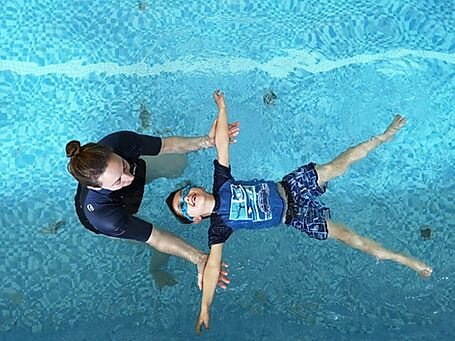Find out how the water can meet Sensory Needs
Imagine that you are trying to learn a new skill,for example a language. You really want to learn, but someone is making a sound like fingernails being dragged down a blackboard, it hurts your ears, you cannot concentrate properly, you get annoyed, frustrated. For some people, other sensory inputs cause this same “pain” that stop themconcentrating, others the sensation of touching foam soby putting a cover on our floats we remove this uncomfortable sensation, with the result being that a person is not overwhelmed by sensory input and can then concentrate.
Another benefit of the cover is it protects the floats from biting or chewing, a tendency many children have, linked to their sensory tolerance issues, or needs. This avoids the risk of a child choking on a piece of non-digestible foam. It also allows the young person to focus on what the instructor/coach/teacher/parent is saying without the sensory distraction enabling them to complete the task.
SWiRL offers unique covers for floats
Children with sensory needs can really benefit from being in water.
Swimming or just being in water offers children a constant feeling all over their body, pressure is slightly greater than air and once the child feels confident in water they are in a safe and secure environment when they submerge their world changes, a lot of the outside world is shut out with no unfiltered or unwanted audio or visual information bombarding them. It allows the child to take out the unfiltered audio/visual information and provides pressure to the joints that allows a comforted sense and allows the child to understand where they are in time and space.
2. Promotes Body Awareness Swimming & moving in the water enhances sensory inputs
Swimming and moving in the water enhances sensory input. This further develops the physical awareness of the child and improves their motor skills. The water provides unique proprioceptive feedback, that is the increased pressure allows them to understand where they are in time and space which can really help a child to understand how to engage specific muscles for specific actions. Hands-free swimming aids (like the Turtle Pack Swimming Aid) allow children the independence to move freely in the [JH1] water, paying attention to how their body feels when they move against or with the water without distraction from other sensory inputs. Swimming aids that are wearable and don’t restrict or affect arm movements are particularly good for this. A good hands free swimming aid like the Turtle Pack also offers complete freedom of movement so that the swimmer can rotate in the water and explore motion on their front and back
Steph from SWiRL teaches the values of learning to float on your back for water safety
· 3. Strengthens and develops muscle tone
This is hugely important for children with medical conditions that may impact their ability to exercise. Swimming is great exercise that takes less strain on your physical body than any other form of exercise. Nearly every muscle within your body is used at some point.
“Moving the body through the water can also build low muscle tone as gross motor skills improve and gives your child the coordination and strength they need to function better outside away from the water” *www.aaspeech.com/sports-for-children-low-muscle-tone-hypotonis/


